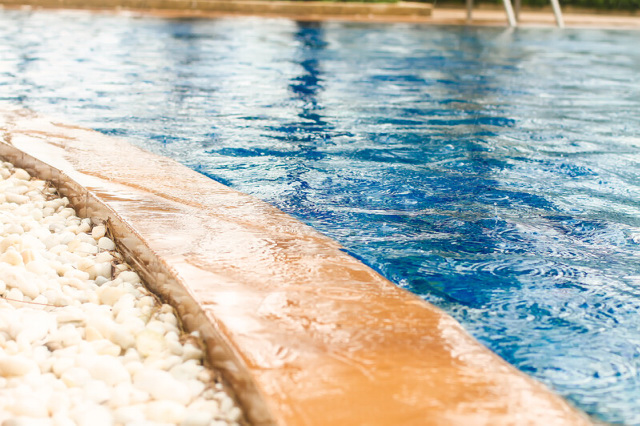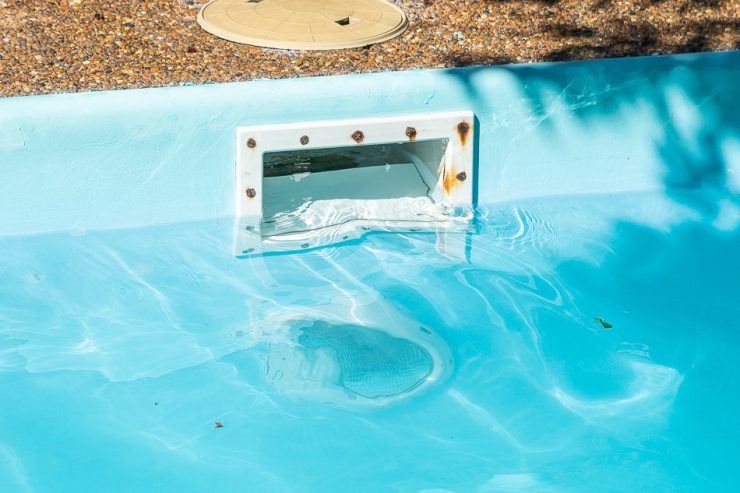A crucial part of pool maintenance is keeping the right amount of water in the pool, but this becomes difficult during heavy rainfall, floods, storms, and pools can overflow.
So what is pool overflow? And how does it affect your pool?
Let’s find out.

Article Contents
What is Pool Overflow?
Pool overflow refers to a situation when the water in the pool is more than the maximum capacity of the pool. Pool overflow occurs when the water in your pool begins to spill over the top.
Pool overflow usually happens during a storm or flood and is more common in areas with heavy rainfall or where the amount of rainfall is more than 3 inches.
Usually, pools are built to handle up to 3 inches of rainfall. But if the rainfall exceeds 3 inches, many pools will experience pool overflow.
At 5 inches of rainfall, most pools, if not all pools will overflow.
Read on to find out the problems caused by overflow and how to prevent it.
How Full Should The Pool Be?
The ideal water height in a pool should be at the mid-point of the skimmer. This applies to all types of pools. The minimum water level for a pool regardless of the type of pool is one-third the height of the skimmer box.
So to be on the safer side, keep the pool water level between one-third and the mid-point of the pool skimmer opening.
To understand the ideal pool water level, you need to know how the water in the pool flows.
The pool water enters the skimmer basket first. Here, large debris in the water is trapped in the basket before the water then the pump pulls the water into the pool filters.
The filter sucks in the water and cleans it by trapping tiny contaminants that the skimmer basket missed. The water then flows into the pool through return jets.
If the water level is below the mid-point of the skimmer basket, then the pump will be starved of water. This will cause the pump to suck air, cavitate or possibly burn out.
Now, let’s check out what happens when the pool level is too high.

What Happens If The Pool Level is Too High?
When the water level is higher than the skimmer basket, then the pool is at a high risk of pool overflow. Debris won’t be trapped in the skimmer basket. Instead, the debris will be deposited back in the pool.
This is the biggest issue with a water level that is too high.
What Happen When Inground Pool Level Is Too High?
When the water level gets too high in an inground pool, the water spills over and onto the deck or pool surrounds. And unless you’re fastidious about cleaning, the surrounds will likely have dust, food and drink spills and the likes on it.
The pool water then washes all of this debris and contaminants back into the pool.
There is also an increased chance of water flowing underneath the deck or surround. When water gets under the deck, it can lead to wood rot or weakening of the deck supports if the drainage is not good.
If this is left unchecked, the whole surrounding could suffer expensive structural damage.
A high pool level occurs during a pool overflow and can negatively affect your pool in the following ways:
Vinyl Liner Pool Damage
Liner pools especially are affected by pool overflow. The excess water can get downside and behind the pool liner causing it to lose its seal.
When the pool liner loses its seal, it starts to develop water-logged or soft spots which will cause the pool liner to wrinkle and eventually tear.
Related Reading: Which Chlorine to Use for Vinyl Liner Pools?
Diluted Pool Chemicals
Pool chemical amounts are based on the size of the water in the pool.
When there is pool overflow, the excess water dilutes the pool chemicals already in the pool. This makes the chemicals less effective, which can lead to algae and other problems.
Unbalanced Pool Chemistry
Pool overflow can also offset the pool water chemistry especially in cases of acidic rain. Phosphate levels, pH, alkalinity, chlorine, calcium and stabilizer can all be affected.
Make sure you test your water after a lot of rain.
Use a high quality test kit like this one:
- Tests total alkalinity, free/combined chlorine, cyanuric acid, calcium hardness & pH
- Extremely accurate (better than test strips)
- For pools & spas
Flooded Yard
This is more common in above-ground pools. When there is pool overflow, the excess water pours out of the pool.
Uncontrolled water like this can cause flooding in the yard and get into places where you don’t want water – like your home.
Structural Damage To Above Ground Pools
Of course when there is pool overflow, the excess water could strain the pool walls for above ground pools. Particular pools like Intex Easy-Set Pools.
Further Reading: Intex Easy Set Pool Reviews 2021: A Detailed Buyer’s Guide
If the pool is filled beyond the manufacturer’s recommendations, the extra water and force could cause the pool frame to expand, crack, and eventually give way.
So how do you deal with pool overflow? Keep reading to find out how.
How To Deal With Pool Overflow
The best way to deal with pool overflow is to partially drain the pool or reduce the pool level.
This task is easier if you have a sand filter or DE filter.
Sand or DE Filter
For pools with sand filters or DE filters, you can reduce the water level by following these steps:
1. Turn off the pool pump
2. Connect a garden hose or backwash hose if your pool waste outlet isn’t permanently plumbed in. Ensure the hose is placed in an area where drainage is allowed. Your yard isn’t a good option because it can cause flooding. Make sure it doesn’t run into your neighbours’ yards either (you won’t make any friends that way!).
3. Set the multiport to waste setting.
4. Run the pump. As soon as you turn on the pool pump, water will rush out of the pool through the hose and out.
5. Allow the water to drain, so the pool water level is 1/3 to 1/2 up the skimmer box.
6. Turn off the pool pump to stop the drainage.
7. Set the multiport valve back to filter setting.
Cartridge Filter
If your pool doesn’t have a sand filter or DE filter, then it will be designed with a cartridge filter.
Most cartridge filter setups will be equipped with a 3-way valve (not a multiport valve like sand filters). You can reduce the water level by following these steps:
1. Turn off the pool pump: This stops the pool pump from circulating water.
2. Attached a backwash hose or garden hose to the 3-way valve outlet.
3. Turn the 3-way valve to waste setting. This will be located off to the side of the filter. Usually you only want to partially turn this. Doing this will limit the flow and ensure the water level doesn’t drain too quickly.
4. Run the pool pump: turn the pool pump back on. The water will start flowing out of the hose.
5. Drain until the pool level is lowered to about 1/3 to 1/2 way up the skimmer.
6. Turn off the pump and remove the hose and set the 3-way valve back to the filter position.
What if reducing your pool level manually isn’t your thing? Well, there is pool equipment that automatically reduces the pool level to stop pool overflow.
Let’s check out this equipment.
Automatically Reducing Pool Water Level
Pool Levelers
Pool levelers are designed with a floater system that monitors the pool water level.
Usually, pool levelers are designed to detect low water level in the pool and auto-fill the pool. This eliminates the need to manually refill the pool.
But, there are pool levelers that also drain water from the pool when the water level gets too high.
I haven’t seen one of these products in the U.S. but there is one designed by WaterCo available for shipping from Australia.
The WaterCo automatic pool leveler is designed with an overflow connection that drains water from the pool during a pool overflow.
Overflow Drains
There are also overflow drains. Some pools have a drain built into the water so when the water level reaches it, the water simply drains out.
However, dealing with pool overflow is good and all but you wouldn’t need to even worry about it if you can prevent it.
So how do you prevent your pool from overflowing? Let’s take a closer look at that.
How To Prevent Pool Overflow
The following methods will help you prevent pool overflow:
Lower the Water Level Before a Storm
Your best bet is to take some water out of your pool when you suspect a storm or flood is imminent. If there is a lot of rain predicted you can lower the water below the skimmer, however, if you do this, DO NOT run the pump as it will run dry and damage it.
You can also monitor the situation and if you don’t mind getting wet, go out during the rain and drain some water out of the pool if the level is getting too high.
Install a Drainage System
A pool overflow drainage system will help the pool cope better with excess water flow. Though this method is a bit high-priced.
The drainage system is usually installed around the rim of the pool to prevent excess water and flood water from interfering with the pool’s functioning.
However, during cases of storms and floods, the pool drainage system is usually limited.
This is because water levels in your pool can rise well over 6 inches in these cases and most drainage systems can’t handle that much overflow.
So in extreme cases, you’ll still need to drain water manually to assist the drainage system.
Related Reading: How To Clean a Pool After a Storm or Flood
Final Thoughts
Overall, pool overflow poses many risks to your pool ranging from filthy water to damaged pool equipment.
But all of these risks can be averted or at least reduced with a proper overflow drainage system and pool maintenance.
With these in place, you’ll have to worry less about what happens in your pool when it rains.


